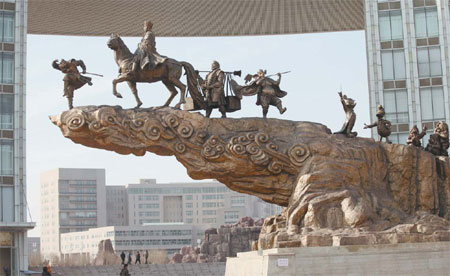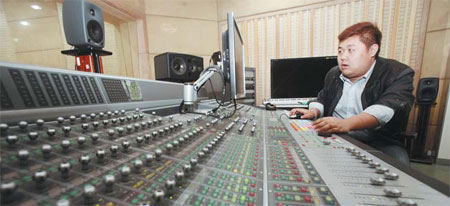Big Panda v Little Rabbit story
Updated: 2013-05-10 07:12
By Yang Yang (China Daily)
|
||||||||
|
National Animation Industry Park in Tianjin is the largest animation center in China. It works on animations works and online games, as well as helping foreign partners render animated movies. Jia Lei / China Daily |
|
The recording studio in the Public Technical Service Platform allows visitors to lay down musical tracks. Jia Lei / China Daily |
China's movie animators muster forces in tianjin to match hollywood's screen successes
It was no contest. In the summer of 2008, Hollywood's animation studios kicked their Chinese counterparts out of the ring in technique and power. To add insult to injury, they did it in true Chinese style.
That was Kung Fu Panda, which took $26 million to become the highest-grossing animation film released in China.
In true plucky underdog style, the humbled, undervalued but newly inspired Chinese animators fought back, and in the summer of 2011 released five features, including the first to use 3D - The Legend of a Rabbit.
Sadly, although they all showed marked improvement in quality of animation and special effects, like the hero bunny's ears, they flopped. The Legend of the Rabbit grossed only 20 million yuan ($3.2 million; 2.47 million euros) in China. It had cost around 150 million yuan to make.
Of course, it didn't help that the superior sequel Kung Fu Panda 2 was released a couple of months before, going on to take a record-breaking $93 million for an animation film in China.
Meanwhile, effects-laden Transformers 3 earned 1 billion yuan to dominate the Chinese box office overall that year, proving, if nothing else, the prolific rise, and the tastes, of the country's cinema goers.
That is something worth fighting for, and for Chinese animation moviemakers at least, they are gearing up for the next round against Hollywood in Tianjin, the coastal city 111 kilometers east of Beijing.
"Comparatively speaking, there's a sad consensus that domestic animated movies lag far behind Hollywood, not only in plotting but also in production techniques, so people are unwilling to spend money on such movies," says Dong Fachang, producer of The Legend of a Rabbit, at his office in Tianjin North Film Group. "Another thing is that many Chinese moviemakers still position animation movies to attract children only."
Like its panda nemesis, Rabbit was aimed at a general audience, and in plotting and visual effects, it is considered a milestone work in China. But while critics and viewers recognized its technical qualities, they bemoaned the storytelling.
Rabbit "hobbles rather than hops, but has consistently good special effects", wrote the Hollywood Reporter. The screenwriters "hadn't pulled any rabbit out of their hats" with storytelling techniques "as straight as an arrow".
But while that creative side - concepts and scripts - which relies as much on chance as genius, there is still a lot that can be achieved on the technical side through animation techniques and special effects, and in reducing time and cost.
This means big room for improvement and huge business opportunities in China, especially when the country's movie market value has been growing by 30 percent annually in recent years.
Tianjin, a municipality highly developed in heavy industry, is now moving fast to narrow the gap through not only technological innovation but also international cooperation.
At the city's National Animation Industry Park is a global village created from animated movies. Statues of classic characters from home and abroad stand alongside each other: Disney's Mulan and her dragon Mushu, China's Monkey King and the Mole from the Czechs.
Inside the National Supercomputer Center at the park, the country's fastest computer called the TH1 has greatly accelerated the rendering of animated movie images. Work that normally takes six to eight months can now be done in one or two.
As well as many domestic animation works and online games, TH1 has helped Sony Pictures render two animated movies - Tekken: Blood Vengeance and Residential Evil: Regeneration.
Nearby, in the green surrounds of the Motion Capture Room, two men in green-dotted black body-stockings are performing various movement routines. Around them, 24 digital cameras capture their movements and the data are transferred to a computer. On its screen two animated characters standing in a street are going through the same motions. The system can carry out real-time capture, real-time coloring and 3D rendering of the face and body.
In a bigger studio, 48 cameras can capture six people's movements simultaneously. The hardware is Avatar standard, a technician boasts.
These cutting-edge facilities are supported in the NAIP by the Public Technical Service Platform, which covers 10,000 square meters, and includes studios for viewing, recording and channel mixing.
Due to government support, the hiring cost for the recording studio is a mere 300 yuan ($49; 37 euros) an hour if anyone wanted to lay down some music tracks.
Companies are also busy here developing their own technology. Fufengda Films, based in downtown Tianjin, has come up with a system to transfer 2D films to 3D. The company has 50 patents.
Such advances are attracting customers from the United States, Europe, Japan and Canada.
"If everything goes smoothly, the orders in 2013 will triple last years' value, reaching 300 million yuan," says Fufengda chairman Liu Yong.
Vasoon Animation, based in Beijing, has set up shop in Tianjin's animation park with 70 employees. Like Tianjin North Film Group, Vasoon also took a beating from Kung Fu Panda 2 in the summer of 2011, when its first animated movie Kuiba screened. The investment was 35 million yuan but domestic box office was only 3.5 million yuan.
However, Vasson has dusted itself down and, undeterred, is working on a sequel.
"Apart from the story, the biggest difference for this one is we have applied a technology to three-dimensionalize two-dimensional pictures, which was developed by ourselves," says Wang Chuan, president of the company.
"The quality of the Kuiba 2 is also better than the first movie because over the years we have accumulated knowledge and experience."
But as well as competition with other countries' movie industries, there is also much cooperation.
"We are now negotiating with a Hollywood team that took part in Avatar," says Jiang Jian, deputy general manager of Tianjin Eco-city Animation Park Investment and Development Co Ltd, which manages the NAIP. "We hope they can give us some inspiring guidelines so we can introduce advanced concepts and technologies."
Last October, Yellow Mountain (Tianjin) Film decided to build the world's largest virtual digital studios in the park, with an investment of 120 million yuan for the first stage of the project. There will be six digital studios, each occupying 1,500 sq m.
Jiang Ping, president of the company, used to work in Toronto and Los Angeles in the movie industry, but was drawn back to China due to its huge market potential.
"Now films are demanding greater amounts of visual effects, especially after Kung Fu Panda and Avatar," she says. "Without special effects, movies will lack visual impact and attraction. In the US, the development of movie industry relies on technological innovation. From this angle, I think China needs high-level post-production companies.
"The supercomputer in Tianjin is also one of the reasons we decided to go there. The computing speed will cut down our production cycle and thus the cost.
"We hope we can produce several influential movies each year here. These productions could also attract more talent and drive the development of the local economy and tourism."
Jiang says the company plans to spend 18 months training 300 people for the project.
One of the biggest coups for China's movie industry in 2012 was James Cameron choosing to cooperate with Tianjin North Film Group in setting up its 3D movie studio in Tianjin.
"3D movies are the future of the movie industry, which we are focusing on developing," says Wang Dafang, president of the group.
Tianjin North is working with French documentary director Luc Jacquet on a film about forests around the world, and is negotiating work with American studios in making the sequels to Hidden Dragon and Crouching Tiger and 2012.
And, perhaps most importantly, the group's Dong Fachang is producing The Legend of a Rabbit 2, due for release next year. Perhaps this one will stand up to the might of Kung Fu Panda.
yangyangs@chinadaily.com.cn
(China Daily 05/10/2013 page12)

 Michelle lays roses at site along Berlin Wall
Michelle lays roses at site along Berlin Wall
 Historic space lecture in Tiangong-1 commences
Historic space lecture in Tiangong-1 commences
 'Sopranos' Star James Gandolfini dead at 51
'Sopranos' Star James Gandolfini dead at 51
 UN: Number of refugees hits 18-year high
UN: Number of refugees hits 18-year high
 Slide: Jet exercises from aircraft carrier
Slide: Jet exercises from aircraft carrier
 Talks establish fishery hotline
Talks establish fishery hotline
 Foreign buyers eye Chinese drones
Foreign buyers eye Chinese drones
 UN chief hails China's peacekeepers
UN chief hails China's peacekeepers
Most Viewed
Editor's Picks

|

|

|

|

|

|
Today's Top News
Shenzhou X astronaut gives lecture today
US told to reassess duties on Chinese paper
Chinese seek greater share of satellite market
Russia rejects Obama's nuke cut proposal
US immigration bill sees Senate breakthrough
Brazilian cities revoke fare hikes
Moody's warns on China's local govt debt
Air quality in major cities drops in May
US Weekly

|

|










